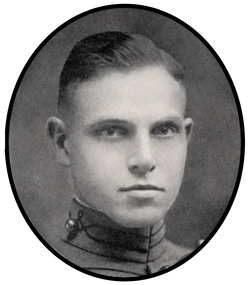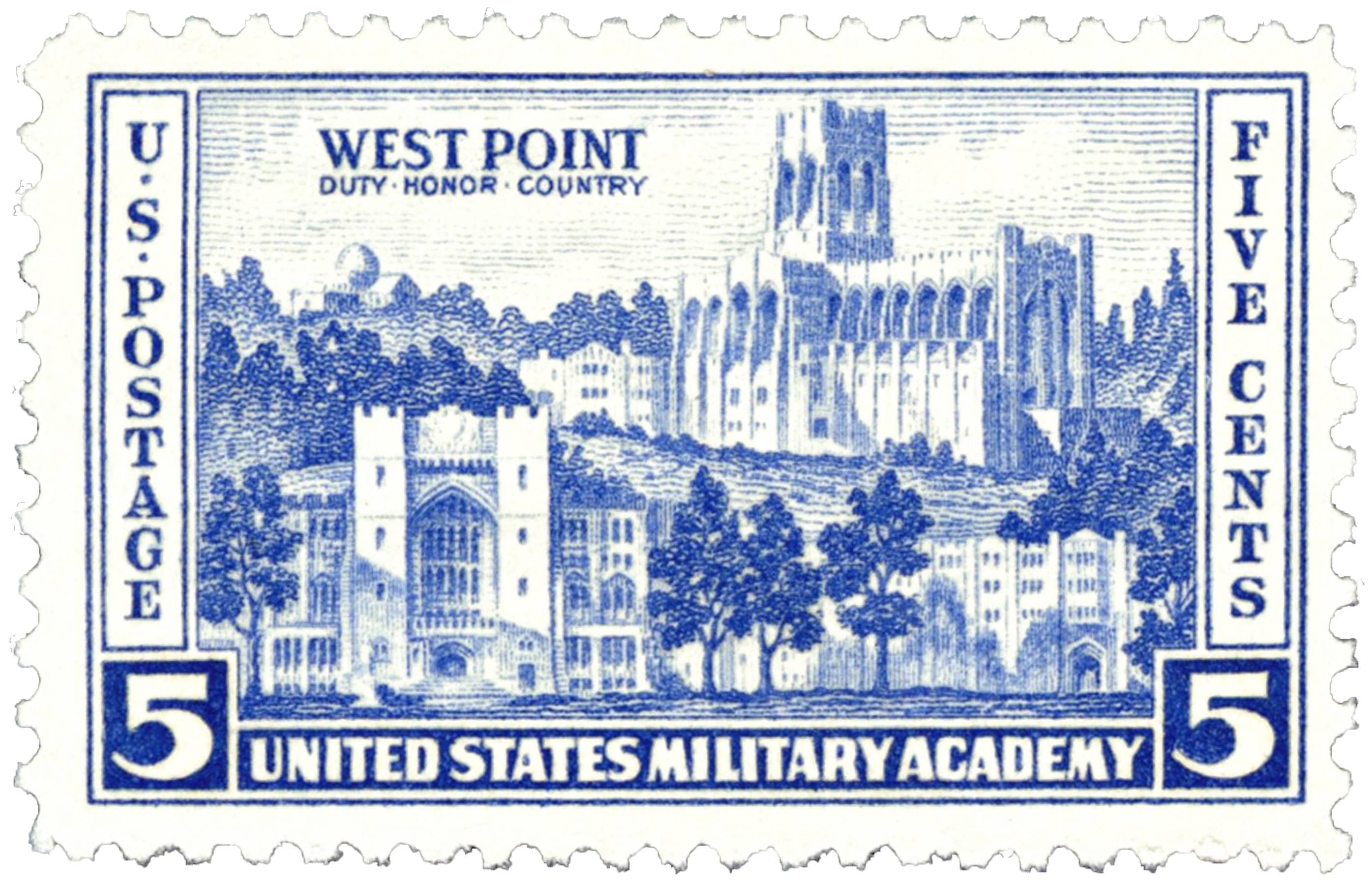He was the son of David W. Schick and May Thomas Schick.
According to the 1930 Census for Newburgh, Orange County, New York, he was age 23 at the time of his marriage for a year of marriage to Frances M. Moore about 1920.
They were the parents of two children.
Lawrence Edward Schick was born on September 20, 1897 in Chicago, Illinois. In 1916, his family moved to California, where the same year he entered Pomona College. After one year at Pomona World War I began and he entered the Army, serving as an enlisted man until he won an Army appointment to the Academy. He entered the Academy in June 1918 with the Class of 1920. Within five months the class became the senior class at West Point, as all upper classmen had been graduated early for the war. Upon graduation in 1920, he received his commission in the Cavalry and attended the Cavalry School at Fort Riley. Then, he was assigned to the 11th Cavalry at the Presidio of Monterey in California. While in California, he married Frances May Moore, his pre-college sweetheart. After Monterey, he was assigned to the 26th Cavalry at Camp Stotsenburg in the Philippines. Then from 1925 to 1928, he was Instructor of Drawing at the Academy where the Department Head was Colonel, later Brigadier General, Roger Alexander. In 1933, after three years with the 13th Cavalry at Fort Riley, General Alexander requested he study at Ohio State University and then return to West Point as Assistant Professor of Drawing. From 1934 to 1938 after his return to the Academy, he was the immediate assistant of General Alexander. Scheduled to leave West Point in 1938, he requested and was assigned to the Adjutant General's Department. During the next four years, he served as Assistant AG of the 2d Infantry Division in Texas, of the 4th Corps Area in Georgia, of the 1st Armored Division in Kentucky and from 1941 to 1942 as the Adjutant General of the Alaskan Department. In Alaska, he participated in the Aleutian Campaign under General Buckner and was awarded the Legion of Merit. In 1944, the Tenth United States Army was formed under the command of General Buckner. Then a Colonel, he was designated its Deputy Chief of Staff and moved with the Tenth to Hawaii. In February 1945, he was advanced to the grade of Brigadier General. He organized the Tenth Army Headquarters and began the personnel and logistic planning for the invasion of Okinawa. He participated throughout the entire campaign, in which his commander, General Buckner, was killed in action. He was awarded the Distinguished Service Medal. The citation reads in part:
Brigadier General Lawrence E. Schick performed exceptionally meritorious and distinguished services in a position of great responsibility during the period July 17, 1944 to June 21, 1945. As Deputy Chief of Staff, Tenth Army, General Schick was responsible for the detailed organization of the Army Headquarters into a smooth-working efficient unit. In addition, he was responsible for supervision of personnel and logistics and coordinated these matters with various Army, Navy, Marine and Air headquarters so effectively as to make his contribution to the success of the Ryukyus campaign exceptionally outstanding.
At the end of World War II, he was assigned to Korea, where he was a member of the group which received the Japanese surrender. He then served as Head of the National Defense Planning Agency in the Provisional Military Government of Korea where he directed the initial planning for the development of the South Korean Military establishment. In 1946, he was selected and made Professor of Military Topography and Graphics at West Point. For this service, he was awarded the oak leaf cluster to the Distinguished Service Medal. On September 30, 1961, he retired with 43 years of service, 26 of them at West Point and moved with his wife to Carmel, in the Monterey area. He was often recalled as a consultant on architecture, sculpture, portraits and memorials at West Point. On October 14, 1967, he passed away at age 70 at the Carmel Community Hospital. Survivors included his wife, Frances; one daughter; one son, Major John L. Schick, USMA Class of 1955 and four grandchildren, one of whom was a member of the USMA Class of 1966.
Source: United States Military Academy Association of Graduates memorial.
He was the son of David W. Schick and May Thomas Schick.
According to the 1930 Census for Newburgh, Orange County, New York, he was age 23 at the time of his marriage for a year of marriage to Frances M. Moore about 1920.
They were the parents of two children.
Lawrence Edward Schick was born on September 20, 1897 in Chicago, Illinois. In 1916, his family moved to California, where the same year he entered Pomona College. After one year at Pomona World War I began and he entered the Army, serving as an enlisted man until he won an Army appointment to the Academy. He entered the Academy in June 1918 with the Class of 1920. Within five months the class became the senior class at West Point, as all upper classmen had been graduated early for the war. Upon graduation in 1920, he received his commission in the Cavalry and attended the Cavalry School at Fort Riley. Then, he was assigned to the 11th Cavalry at the Presidio of Monterey in California. While in California, he married Frances May Moore, his pre-college sweetheart. After Monterey, he was assigned to the 26th Cavalry at Camp Stotsenburg in the Philippines. Then from 1925 to 1928, he was Instructor of Drawing at the Academy where the Department Head was Colonel, later Brigadier General, Roger Alexander. In 1933, after three years with the 13th Cavalry at Fort Riley, General Alexander requested he study at Ohio State University and then return to West Point as Assistant Professor of Drawing. From 1934 to 1938 after his return to the Academy, he was the immediate assistant of General Alexander. Scheduled to leave West Point in 1938, he requested and was assigned to the Adjutant General's Department. During the next four years, he served as Assistant AG of the 2d Infantry Division in Texas, of the 4th Corps Area in Georgia, of the 1st Armored Division in Kentucky and from 1941 to 1942 as the Adjutant General of the Alaskan Department. In Alaska, he participated in the Aleutian Campaign under General Buckner and was awarded the Legion of Merit. In 1944, the Tenth United States Army was formed under the command of General Buckner. Then a Colonel, he was designated its Deputy Chief of Staff and moved with the Tenth to Hawaii. In February 1945, he was advanced to the grade of Brigadier General. He organized the Tenth Army Headquarters and began the personnel and logistic planning for the invasion of Okinawa. He participated throughout the entire campaign, in which his commander, General Buckner, was killed in action. He was awarded the Distinguished Service Medal. The citation reads in part:
Brigadier General Lawrence E. Schick performed exceptionally meritorious and distinguished services in a position of great responsibility during the period July 17, 1944 to June 21, 1945. As Deputy Chief of Staff, Tenth Army, General Schick was responsible for the detailed organization of the Army Headquarters into a smooth-working efficient unit. In addition, he was responsible for supervision of personnel and logistics and coordinated these matters with various Army, Navy, Marine and Air headquarters so effectively as to make his contribution to the success of the Ryukyus campaign exceptionally outstanding.
At the end of World War II, he was assigned to Korea, where he was a member of the group which received the Japanese surrender. He then served as Head of the National Defense Planning Agency in the Provisional Military Government of Korea where he directed the initial planning for the development of the South Korean Military establishment. In 1946, he was selected and made Professor of Military Topography and Graphics at West Point. For this service, he was awarded the oak leaf cluster to the Distinguished Service Medal. On September 30, 1961, he retired with 43 years of service, 26 of them at West Point and moved with his wife to Carmel, in the Monterey area. He was often recalled as a consultant on architecture, sculpture, portraits and memorials at West Point. On October 14, 1967, he passed away at age 70 at the Carmel Community Hospital. Survivors included his wife, Frances; one daughter; one son, Major John L. Schick, USMA Class of 1955 and four grandchildren, one of whom was a member of the USMA Class of 1966.
Source: United States Military Academy Association of Graduates memorial.
Family Members
Sponsored by Ancestry
Advertisement
Records on Ancestry
Advertisement
















